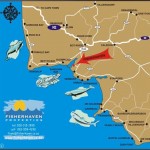Bot River Estuary – Should we interfere?
- Feb
- 08
THE FAUNA AND FLORA AND THEIR ECOLOGY
The ecology of the Bot river estuary reflects the physical conditions outlined earlier. All the aquatic species are tolerant of salt or brackish water, except for three species of freshwater fish (carp, Cyprinus carpio, kurper, Oreochromis mossambicus and largemouth bass,Micropterus salmoides) which only venture into the estuary when salinities are very low. Because the physical conditions are so variable and unpredictable, the species diversity in the estuary is low, since relatively few species can tolerate such a wide range of conditions.
Four aquatic plant species dominate the plant life. These are Ruppia maritime and Potamogefon pectinafus, both water weeds, andPhragmites australis and Scirpus linoralis, both reeds. Of these, Ruppia is by far the most important and it is the beds of this species that form the main habitat for most of the invertebrate fauna and many of the fish species. It is on this species that most of the organisms in the Bot river estuary ultimately depend.
Of the 32 invertebrate species recorded from the estuary, only six are ever present in consistently large numbers. The sand prawn,Callianassa kraussi, is present in great densities in the lower reaches of the estuary, although it should be noted that it cannot breed once salinities drop below 12 parts per thousand, a fairly regular occurrence in this estuary. A small mussel, Arcuatula capensis, which lives nestled among the roots of Ruppia is also common. The remaining important species are all crustaceans: the shrimp-like tanaid,Apseudes digitalis; the amphipod, Melita zeylanica and the isopods, Cyathura estuaria and Exosphaeroma hylocoetes. The latter looks rather like an aquatic wood louse but is an herbivore capable of digesting the bacteria growing on weeds.
The fish fauna with 32 species is, by contrast, quite diverse. (Refer to the list of fish species.) These can be divided into four categories based on where they breed. Firstly, there are those that breed only in estuaries, including one newly discovered species of klipvis, Clinus spatulatus, which is endemic to the Bot river estuary. Secondly, there are species that breed both in estuaries and in the sea, such as silversides, which are an important source of food for many angling species.
A third group includes species that can breed only at sea, while a fourth group breeds in fresh water. The third category forms the largest group and these species mostly make use of the estuary as a nursery area. The young fish move into the estuary while the mouth is open and remain there until the onset of sexual maturity. The reason for this is that they are relatively safe from predators in estuaries and having access to abundant food, are able to grow faster than at sea. They must, however, return to the sea to breed, thereby completing their life cycle. It is these fish (leervis, steenbras and elf) which are the popular angling and table fish.
With the exception of the freshwater fish (all alien species such as carp and bass), the angling fish in the Bot river estuary die if the salinity drops too low (less than five parts per thousand). On several occasions there have been massive mortalities of fish with thousands of putrefying steenbras, leervis and stumpnose washing up on the shore.
The birdlife is also varied and over 50 species have been reported from the estuary. The marshes at the head of the Kleinmond Estuary are particularly species-rich. At certain times the Bot river estuary supports over 36,000 redknobbed coots, representing about 28 per cent of the total coastal coot population in South Africa. Other important species include ducks, greater and lesser flamingos and cormorants.
Of the total amount of weed that grows in the estuary, about ten per cent is eaten by coots and probably a further ten per cent by herbivorous invertebrates. The fish eat very little weed themselves, although they do feed on both herbivorous invertebrates and other fish. Filter feeders such as the clam, Arcuatula and the sand prawn, Callianassa feed on bacteria-rich detritus produced by the breakdown of weeds by bacteria. Indeed, bacteria are responsible for most of the consumption of weed in the Bot river estuary.


Recent Posts
- The Pros And Cons Of Solar Power
- 3 Things Private Sellers Wish they Knew (That Estate Agents Do!)
- Top 5 Tips For Sellers in a Buyers’ Market
- Top 5 Tips For Buyers In A Buyers’ Market
- Your Property Title Deed – A Short History
Contact Us
Fisherhaven Properties
Frans Theunissen
Tel: 082 559 4290
Tel: 028 315 1990
Fax: 086 660 4823
info@fisherhaven.co.za

Please ask us about long-term property rentals in the area.


